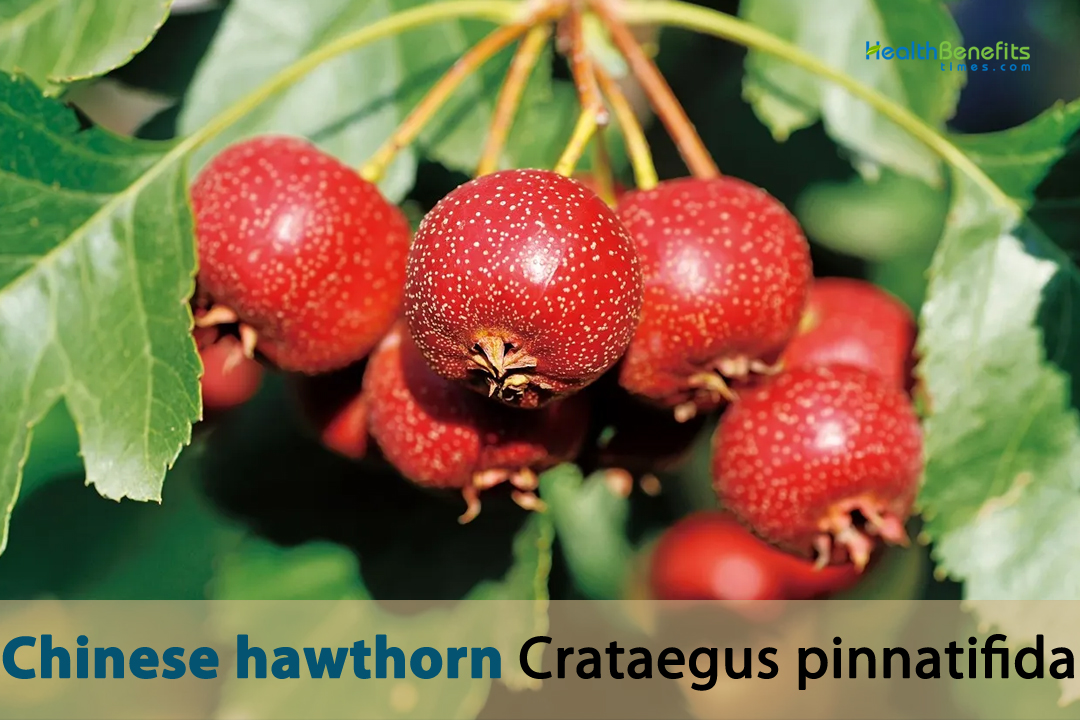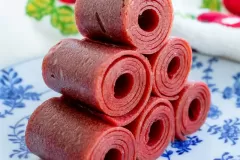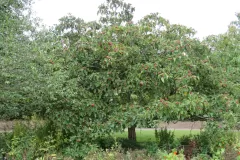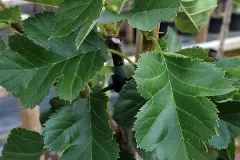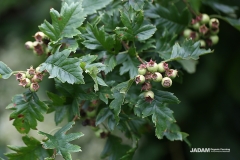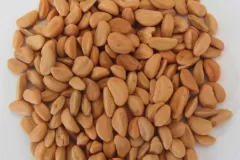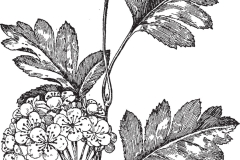| Chinese hawthorn Quick Facts | |
|---|---|
| Name: | Chinese hawthorn |
| Scientific Name: | Crataegus pinnatifida |
| Origin | Northeast Asia including Mongolia and China |
| Colors | Initially green turning to bright red or sometimes deep crimson as they mature |
| Shapes | Small berries round to oval in shape, and measure about 1 to 2 cm in diameter |
| Flesh colors | Crisp and juicy |
| Taste | Sweet, sour |
| Major nutrients | • Vitamin C • Dietary Fiber • Potassium • Flavonoids • Triterpenoid Saponins • Iron • Calcium • Vitamin B • Carotenoids |
| Health benefits | Heart Health, Cholesterol Regulation, Blood Pressure Management, Anxiety and Stress Reduction, Digestive Health, Anti-Inflammatory Effects, Immune Support, Mild Sedative Properties |
| Name | Chinese hawthorn |
|---|---|
| Scientific Name | Crataegus pinnatifida |
| Native | Northeast Asia including Mongolia and China and is widely distributed throughout the country. It has also been cultivated in various other parts of Asia, Europe, North America and the Russian Far East |
| Common Names | Chinese hawthorn, Chinese haw, Thorn apple, Hawthorn plum, Hawberry, Chinese hawthorn bush, Chinese hawthorn plum, Red haw, Chinese hawberry, Mountain hawthorn, Chinese hawthorn shrub, Mayapple, Chinese red berry, Hawthorn berry, Chinese hawthorn tree, Chinese apple, Chinese wild hawthorn, Hawthorn thorn, Hawthorn rose, Chinese hawthorn bush, Hawthorn tree, Red fruit hawthorn, Hawthorn pear |
| Name in Other Languages | Arabic: Al-za’arur al-sini (الزعرور الصيني) Assamese: Chīnā hāthipak (চীনা হাথিপক) Azerbaijani: Lələkvari-kəsikyarpaq yemişan Belarusian: Hloh piorystanadrezany (глог пёрыстанадрэзаны) Bengali: Chīnā hāthipēca (চীনা হাথিপেচ) Bhojpuri: Chinese hawthorn (चाइनी हाथवा) Bulgarian: Kitayski glog (Китайски глог) Chinese: Shan zha, (山楂), Zhōngguó shānzhā (中國山楂), Yama Ue (山植), Shānzhā yè (山楂叶), Sanza ki (山楂木), Shānzhā hé (山楂核), Shānzhā gēn (山楂根), Shānzhā gāo (山楂糕), Shānzhā huā (山楂花), Yě shānzhā (野山楂) Croatian: Kineska glogova Czech: Čínský trn Danish: Kinesisk tjørn, Dutch: Chinese meidoorn English: Chinese haw, Chinese hawthorn, mountain hawthorn Estonian: Sulglõhine viirpuu, Hiina astelpaju Filipino: Tsina hawthorn Finnish: Välkeorapihlaja, Kiinanoratuomi, Kiinankarvia French: Aubépine de Chine German: Chinesische Weißdorn Greek: Kinezikós krataiós (Κινεζικός κραταιός), Kinezikí agriokardía (Κινεζική αγριοκαρδιά) Gujarati: Chā’īnīja hāthōṇ (ચાઇનીઝ હાથોણ) Hebrew: Uts Sini (עוץ סיני) Hindi: Chinese hawthorn (चाइनीज़ हॉथॉर्न) Hungarian: Kínai galagonya Icelandic: Kínversk hagþyrnir Indonesian: Hawthorn Cina Italian: Biancospino cinese Japanese: Oosanzashi (オオサンザシ), Sanzashi (サンザシ) Kannada: Chainīs hāthān (ಚೈನೀಸ್ ಹಾಥಾನ್) Kashmiri: Chinese hawthorn (چائنیز ہوتھاں) Konkani: Chinese hawthorn (चायनीज़ हॉथॉर्न) Korean: Sansa (산사), sansanamu (산사나무), neolp eun ip san sa, jung-gugsansa (중국산사), Jungguk Sansa, neolb-eun-ipsansa (넓은잎산사) Lithuanian: Kinų gervuogės Latvian: Ķīnas dzērveņu Maithili: Chainee haathava (चाइनी हाथवा) Malay: Buah berduri Cina, Buah apel Cina Malayalam: Chainīs hātan (ചൈനീസ് ഹാതന്) Marathi: Chini Hathan (चीनी हाथण) Moldovon: Gherghin Nepali: Cinija haṭṭāna (चिनिज हट्टान) Norwegian: Kinesisk hagtorn Odia: Chainīj hāthana (ଚାଇନୀଜ୍ ହାଥନ) Persian: Za’farān chīnī (زعفران چینی) Polish: Głóg chiński Portuguese: Espinheiro-chinês Punjabi: Cīnī hāṭhaṇ (ਚੀਨੀ ਹਾਥਣ) Romanian: Gălbenele chinezești Russian: Kitayskaya glod (Китайская глод), Boyaryshnik peristonadrezannyy (Боярышник перистонадрезанный) Sanskrit: Chinese hawthorn (चीनी हाथवा) Serbian: Kineski glod (Кинески глод) Sindhi: Chinese hawthorn (چائنيز هوٽهن) Slovak: Čínsky trn Slovenian: Kitajska gloga Spanish: Espino chino Swedish: Kinesisk hagtorn Tamil: Sīṉa arattippaḻam (சீன அரத்திப்பழம்) Telugu: Chainīs hāthān (చైనీస్ హాథాన్) Thai: Sān cā (ซานจา), H̄or̂t̄hx cīn (ฮอร์ธอร์นจีน), Phrik jīn (พริกจีน) Turkish: Çin Alıç Meyvesi Ukrainian: hlid pirchastyy (глід пірчастий), Kytaĭsʹkyy hlid (Китайський глід) Urdu: Chinese hawthorn (چائنیز ہاتھوڑن) Uyghur: دولانا (مېۋە) Vietnamese: Lựu đạn Trung Quốc |
| Plant Growth Habit | Small to medium-sized, thorny (sometimes unarmed), deciduous shrub or a tree |
| Growing Climates | Edges of forests or woodlands, open woodlands, slopes and hillsides, near riverbanks, along the sides of streams, cultivated in orchards, parks, gardens, and along streets, abandoned fields, meadows and grasslands, on sandy soils or stony slopes |
| Soil | Prefers well-drained soil; tolerates a range of soils from clay to sandy and acidic to slightly alkaline |
| Plant Size | 15 to 25 feet (4.5 to 7.5 meters) tall and 6 to 12 inches (15 to 30 centimeters) wide |
| Root | Lateral roots branch out horizontally from the taproot. Lateral roots give rise to smaller, fibrous roots |
| Stem | The main stem or trunk is the central, woody axis that supports the entire plant |
| Bark | Bark is thin and gray and breaks into narrow scales with age |
| Branches | Branches are dark gray, with few straight, brown thorns 1-2 cm in length or, sometimes, without thorns |
| Leaf | Typically oval to elliptical in shape with serrated or toothed edges about 2 to 5 cm long. They are typically dark green on the upper surface and lighter green on the underside |
| Flowering season | April to May |
| Pollinators | Bees and butterflies |
| Flower | Around 1 cm (0.4 inches) in diameter. The flowers are usually white or creamy-white, though some varieties may have slightly pinkish hues. When freshly open, they exude a pleasant scent but become unpleasantly scented with age |
| Fruit Shape & Size | Small berries round to oval in shape, and measure about 1 to 2 cm (0.4 to 0.8 inches) in diameter. They have a smooth and shiny skin |
| Fruit Color | Initially green turning to bright red or sometimes deep crimson as they mature |
| Fruit skin | Thin and somewhat waxy |
| Fruit Weight | Around 5 to 10 grams |
| Flesh | Crisp and juicy |
| Flesh Color | Initially pale yellow to light green turning to a deeper yellow or even a reddish color |
| Seed | Small few millimeters in length. They are typically oval or slightly elongated in shape |
| Flavor/Aroma | Mildly sweet and floral scent |
| Taste | Sweet and tart, with a slightly sour or tangy undertone |
| Plant Parts Used | Leaves, roots, seeds, fruits, flowers, bark |
| Propagation | By seeds, semi-hardwood cuttings and grafting |
| Lifespan | About 20 to 50 years or more under favorable conditions |
| Season | September to October |
| Major Nutrition |
|
| Health benefits |
|
| Available Forms |
|
Plant Description
Chinese hawthorn is a deciduous shrub or tree that is typically small to medium in size, thorny (occasionally unarmed), and typically forms a cylindrical shape with a dense branching habit. Typically, the tree attains a height of 15 to 25 feet (4.5 to 7.5 meters) and a width of 6 to 12 inches (15 to 30 centimeters). The crown may vary in width from 4.5 to 6 meters (15 to 20 feet). The plant is cultivated in abandoned fields, meadows, and grasslands, on sandy soils or stony slopes, at the margins of forests or woodlands, in open woodlands, slopes and hillsides, near riverbanks, along the sides of streams, in orchards, parks, and gardens, and along streets. Although it prefers well-drained soil, the plant can tolerate clay, sandy, acidic, and mildly alkaline soils.
For centuries, the fruit has been incorporated into traditional Chinese cuisine. It is frequently incorporated into beverages, candies, jellies, jams, and treats containing hawthorn. It is distinguished by its distinct acidic flavor. Occasionally, trees are cultivated for their aesthetic qualities. In the spring, they generate clusters of fragrant white blossoms, and in the fall, they produce vibrant berries, which contribute to their widespread use in landscapes and gardens. As an example, thrushes and cedar waxwings regard the fruit as a nutritious food source. It provides assistance to native wildlife populations. The Chinese Lantern Festival is frequently linked with the consumption of a diverse assortment of candies and refreshments derived from hawthorn berries. China is the foremost consumer and producer of hawthorn products, and its cultivation and processing are devoted to a prospering industry.
Roots
Lateral roots emanate from the taproot in a horizontal direction. Lateral roots generate fibrous, diminutive roots. Adventitious roots may also develop on Chinese hawthorn trees. These are roots that develop from stems or branches, among other non-root tissues. They are capable of emerging from both the lower portion of the trunk and the earth. Additional support and stability can be provided to a tree by adventitious roots.
Stem
The main stem or trunk serves as the structural skeleton that runs the length of the plant. Elevated from the root system, it functions as the principal structural component of the arboreal organism. The stem is enveloped in a layer of protective bark. The cambium layer is a narrow layer of tissue located beneath the bark. The aforementioned stratum is accountable for the expansion of the stem in both height and girth (diameter). Produced from the stem of the Chinese hawthorn tree are branches and limbs. In general, branches exhibit a more vertical growth pattern and possess a greater diameter, whereas twigs are more diminutive in size and frequently produce foliage, blossoms, and fruit.
Bark
Generally, the bark of the tree exhibits a gray to brownish-gray hue. The shade may exhibit minor variations contingent upon the particular variety and age of the tree. The epidermis possesses a coarse, scaly consistency. As the tree matures, furrows or ridges may begin to appear. Lenticels are raised, tiny, corky regions on the surface of the bark. These apertures function as minute dots or lines and facilitate gas exchange while permitting a restricted amount of transpiration (water vapor loss).Although the bark can differ in thickness, it is typically quite thin, particularly on younger trees. The bark of an aging Chinese hawthorn tree may develop deeper fissures and fractures. These may impart a more rugged aspect to the bark.
Leaves
Typical leaf shapes range from oblong to elliptical, featuring serrated or toothed margins. Although they may have a minor lobed appearance, they are not profoundly divided. In general, the leaves are small to medium in size, spanning an average of 2 to 5 centimeters (approximately 0.8 to 2 inches) in length. Generally speaking, the underside of the foliage is a lighter shade of green than the upper surface. The degree of variation in pigment may be influenced by the particular variety and environmental conditions under which it grows. On the surface, the leaves are glossy and smooth, and they are frequently oily or leathery to the touch.
The leaves of Chinese hawthorn are arranged alternately along the branches, which means that they emerge one at a time from the stem on alternating sides. Prominent veins emanate from the central midrib of the leaves. Frequently, both the upper and lower surfaces of the leaf exhibit these veins. Before falling from the tree in the autumn, Chinese hawthorn leaves may transform into a variety of yellow, orange, or red hues.
Flowers
Typically, the blossoms of the Chinese hawthorn are slender and arranged in clusters called corymbs or cymes. The diameter of each individual flower is approximately 1 centimeter (0.4 inches). While the majority of the flowers are white or creamy-white, certain varieties may exhibit faint pinkish undertones. Typically, flowers consist of five petals, the form of which is oval or round. A minor degree of petal overlap may contribute to the full and symmetrical appearance of the flower. The flower’s core contains a multitude of stamens adorned with yellow anthers. The stamens, which encircle the pistil, serve the purpose of pollen production. The pistil serves as the primary reproductive organ of the female flower. Typically, it consists of a solitary, elongated style featuring a stigma apexes to facilitate the ascent of pollen for fertilization.
Fruit
Typically, hawthorn berries are round to ovoid in shape and range in diameter from 0.4 to 0.8 inches (1 to 2 centimeters). Their epidermis is glossy and silky. Initially green, berries mature to a brilliant red or, in some cases, a deep crimson hue. Berry coloration may range from yellow to orange in some varieties. Hawthorn berries have a thin, glossy exterior skin. The interior beneath the skin is crisp and juicy, resembling the consistency of apples or pears. Berries have a tart to mildly sweet, sour flavor profile. Although flavors can differ among varieties, they are frequently characterized as tart or mildly acidic.
Seeds
Typically, Chinese hawthorn spores have a length of only a few millimeters. Typically, their shape is oval or marginally elongated. Due to their woody texture and extreme hardness, the seeds are impervious to harm during storage and handling. Typically brown in hue, their precise tint may vary slightly between darker and lighter, contingent upon the fruit’s variety and level of ripeness. While berries generally comprise one to five seeds per berry, this range is subject to variation.
Health benefits of Chinese Hawthorn
Chinese hawthorn has been utilized in traditional medicine for centuries, specifically in European and Chinese herbal traditions. It is believed that the bioactive compounds abundant in its berries, foliage, and flowers provide a variety of health benefits. Several prospective health advantages are detailed below:
1. Heart Health
The prospective cardiovascular health benefit of hawthorn is among its most widely recognized attributes. It is hypothesized to strengthen blood vessels, improve blood circulation, and increase cardiac pumping. Hawthorn is frequently employed in conjunction with other medications to treat hypertension, angina, and congestive heart failure.
2. Antioxidant Properties
Oligomeric proanthocyanidins (OPCs) and flavonoids, which are antioxidants found in hawthorn, protect cells from oxidative stress and free radical-induced injury. Antioxidants have the potential to enhance overall health and potentially inhibit the aging process.
3. Cholesterol Regulation
Hawthorn may help reduce LDL (bad) and triglyceride levels while increasing HDL (good) cholesterol levels, according to some studies. This effect on cholesterol regulation may be beneficial to cardiovascular health.
4. Blood Pressure Management
An examination has been conducted into the potential hypotensive effects of hawthorn. It is hypothesized to function by facilitating improved blood circulation and vasodilation, thereby potentially mitigating hypertension.
5. Mild Diuretic Effect
Hawthorn possesses moderate diuretic properties, which indicate that it may stimulate the production of urine. This can be advantageous for those who suffer from conditions such as edema and water retention, as it aids in the reduction of surplus fluid accumulation within the body.
6. Anxiety and Stress Reduction
There are Hawthorn compounds that have been associated with possible anti-anxiety and stress-relieving properties. They have the potential to induce relaxation and calm the nervous system.
7. Digestive Health
Historio-graphically, hawthorn has been employed to aid in digestion. It potentially facilitates lipid digestion and supports optimal digestive function.
8. Anti-Inflammatory Effects
Hawthorn contains compounds that have demonstrated anti-inflammatory properties. This has the potential to alleviate inflammation in multiple anatomical regions and may provide assistance in the treatment of conditions such as arthritis.
9. Immune Support
Additionally, Hawthorn’s antioxidants may strengthen the immune system by preventing oxidative injury to immune cells.
10. Mild Sedative Properties
Hawthorn has been utilized to induce sleep and tranquility. People who suffer from insomnia or restlessness may benefit from the modest sedative effects of this substance.
11. Antispasmodic Effects
Hawthorn has been historically utilized for its capacity to mitigate muscle spasms and cramping.
Traditional medicine
- The dried fruits of Chinese hawthorn have been utilized as a digestive assist in traditional Chinese medicine.
- Fruit has the following health benefits: antibacterial, anti-cholesterolemic, cardiotonic, hypotensive, stomachic, and vasodilator.
- It has been demonstrated to enhance blood circulation and reduce blood cholesterol levels.
- It is employed for the management of abdominal distension, pain, incontinence, and to stimulate menstruation in Korea.
- Dried fruit has laxative, stimulant, antiscorbutic, stomachic, and alterative properties.
- Hawthorn fruits and flowers are widely recognized in herbal folk medicine for their heart-healthy properties, a claim supported by contemporary scientific research.
- Fruits and flowers possess a direct and moderate heart tonic effect in addition to their hypotensive properties.
- They are particularly prescribed for the management of hypertension and cardiac weakness.
- Seed is suggested for the treatment of labor complications, hernia, and genital edema.
- Branch and leaf material is utilized as an antidote to varnish toxicity.
- Roots are utilized to treat nausea and vomiting.
- Seeds exhibit efficacy in alleviating acne symptoms, including food-related issues induced by chronic diarrhea.
- Tea derived from leaves and flowers demonstrates therapeutic properties for hypertension.
Culinary Uses
- Haw Flakes: These are among the most prevalent and well-liked treats crafted from hawthorn in China. They are compressed into sweet and sour discs after being narrowly sliced.
- Haw Jam: Hawthorn from China can be utilized to produce a delectable jam that can be utilized as a confection filling or as a spread on bread.
- Hawthorn Tea: A beverage made from Chinese hawthorn is refreshing. For added flavor, it is frequently combined with other ingredients such as ginger or goji berries.
- Candied Hawthorn: To candor Chinese hawthorn, a sugar syrup coating may be applied. During the holiday season, these candied hawthorn delicacies that are both sweet and sour are popular.
- Hawthorn Sauce: A sauce made from reduced Chinese hawthorn is frequently employed as a condiment or dipping agent for meat preparations.
- Hawthorn Vinegar: Hawthorn vinegar, produced through the fermentation of Chinese hawthorn, finds application in a variety of dishes including marinades, dressings, and as a flavor enhancer.
- Hawthorn Wine: Alcohol can be infused with Chinese hawthorn to produce a distinctive hawthorn-flavored wine or liqueur.
- Desserts: To impart a tangy taste to delicacies such as jellies, puddings, and ice creams, Chinese hawthorn is utilized as an ingredient.
- Snack Bars: A nutritious and flavorful addition, Chinese hawthorn is frequently integrated into energy bars and refreshment bars.
- Hawthorn Pastries: As a filling for confectionary such as buns and dumplings, Chinese hawthorn imparts a contrast of sweetness and sourness to the dough.
- Fruit Preserves: By preserving Chinese hawthorn with sugar, one can produce a fruit preserve suitable for consumption as a dessert or yogurt garnish.
- Cocktails and Mock tails: Incorporating hawthorn syrup or juice into faux tails and cocktails imparts a distinctively tart and fruity flavor.
Other uses
- Natural Dye: As a natural dye, Chinese hawthorn berries can be utilized to create various hues of red and pink. Throughout history, they were employed to impart distinctive hues to textiles and fabrics in lieu of synthetic dyes.
- Wildlife Attraction: There are numerous species of fauna that can be attracted to Chinese hawthorn trees, including birds. By providing sustenance for birds, the fruit contributes to the creation of wildlife-friendly environments in natural areas and gardens.
- Soil Erosion Control: In order to mitigate soil erosion, Chinese hawthorn plants are occasionally incorporated into landscaping and reforestation initiatives, owing to their substantial root systems and capacity to fortify sloped soil.
- Traditional Crafts: Hawthorn branches have been utilized in traditional crafts of some cultures, including wreath making, basket weaving, and as decorative elements in floral arrangements and centerpieces.
- Aesthetic Uses: Occasional use is made of the aesthetically pleasing blossoms of the Chinese hawthorn tree to embellish bouquets with a lovely and aromatic essence.
- Woodworking: Although not utilized as a primary timber source, the Chinese hawthorn tree’s wood has been employed in small-scale woodworking endeavors, including the creation of tiny tools or utensils.
Side effects
- Gastrointestinal Distress: Ingestion of hawthorn berries or their derivatives in excess may result in gastrointestinal distress, such as nausea, diarrhea, or abdominal cramping. This phenomenon is more probable when ingested in substantial amounts.
- Allergic Reactions: There are those who may develop an allergy to hawthorn. Allergic reactions may manifest as pruritus, pruritus, edema, dyspnea, or respiratory distress. Obtundatory symptoms should be reported to medical authorities without delay following hawthorn ingestion.
- Interaction with Medications: Certain medications and Chinese hawthorn supplements or products may interact negatively. Hawthorn has the potential to reduce blood pressure; therefore, combining it with hypertension medications could result in an unintended consequence of dangerously low blood pressure.
- Blood-Thinning Effects: Hawthorn potentially possesses slight hemostatic properties. It is imperative that individuals taking blood-thinning medications such as warfarin or aspirin consult their healthcare provider prior to incorporating hawthorn supplements into their regimen. Doing so may potentially heighten the risk of hemorrhaging.
- Pregnancy and Breastfeeding: It is advisable for pregnant and lactating women to exercise caution when ingesting Chinese hawthorn supplements or products. Due to the paucity of information regarding their safety in these circumstances, it is advisable to seek guidance from a healthcare professional prior to their application.
- Low Blood Sugar: Hypoglycemia, or insufficient blood sugar, has been reported in some individuals taking hawthorn supplements. Individuals with diabetes or those taking blood sugar-lowering medications should closely monitor their blood sugar levels while using hawthorn.
- Skin Irritation: By-bare-hand contact with hawthorn berries or plants, certain individuals may develop skin irritation or allergic reactions. Those who have sensitive skin should exercise caution when handling hawthorn fruit or plants by donning mitts.
- Interactions with Herbal Supplements: Chinese hawthorn and other herbal supplements with blood-thinning properties, such as ginkgo biloba or garlic, may interact. When combining hawthorn with other herbal remedies, exercise caution.
References:
https://en.wikipedia.org/wiki/Crataegus_pinnatifida
https://www.itis.gov/servlet/SingleRpt/SingleRpt?search_topic=TSN&search_value=836478#null
https://npgsweb.ars-grin.gov/gringlobal/taxon/taxonomydetail?id=12134
https://pfaf.org/User/Plant.aspx?LatinName=Crataegus+pinnatifida
https://www.cabidigitallibrary.org/doi/10.1079/cabicompendium.16506
http://agroatlas.ru/en/content/related/Crataegus_pinnatifida/index.html
https://temperate.theferns.info/plant/Crataegus+pinnatifida
https://gd.eppo.int/taxon/CSCPI
https://plants.usda.gov/home/plantProfile?symbol=CRPIM2


